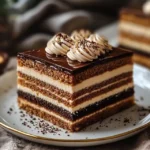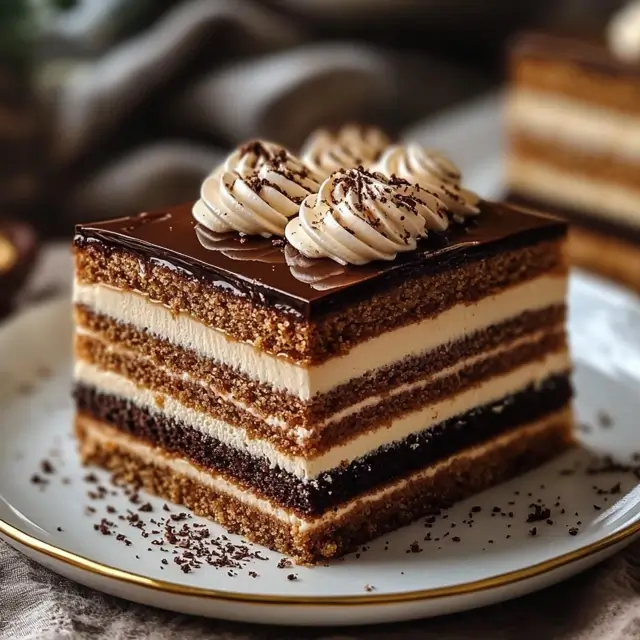Have you ever wondered what makes French patisseries so enchanting? The answer often lies in their most sophisticated creation: Opera Cake. This luxurious dessert represents the pinnacle of baking artistry, combining delicate almond sponge, rich chocolate ganache, and smooth buttercream in perfect harmony. While it might seem intimidating at first glance, mastering this elegant treat will transform you from a home baker into a true dessert artist. Whether you’re planning a special celebration or simply want to challenge your culinary skills, opera cake offers the perfect opportunity to create something truly extraordinary in your own kitchen.
What Makes Opera Cake So Special?
Opera cake stands as one of France’s most celebrated desserts, and for good reason. This rectangular masterpiece consists of multiple thin layers that create a symphony of textures and flavors. The foundation begins with joconde sponge – a light, airy almond cake that provides the perfect canvas for the rich components above.
What sets this dessert apart from other layered cakes is its precise construction and balanced flavors. Each bite delivers a harmonious blend of coffee, chocolate, and almond that dances on your palate. The glossy chocolate glaze on top not only provides visual appeal but also adds a satisfying textural contrast to the soft layers beneath.
Many bakers find themselves drawn to opera cake because it represents a significant milestone in their culinary journey. Successfully creating this dessert demonstrates mastery of several fundamental techniques, from making perfect sponge cake to tempering chocolate properly.
Essential Ingredients for Perfect Opera Cake
Creating an authentic opera cake requires specific ingredients that work together to achieve the classic flavor profile. Here’s what you’ll need for each component:
For the Joconde Sponge:
- 6 large eggs
- 1 cup powdered sugar
- 1 cup almond flour (finely ground)
- 2 tablespoons all-purpose flour
- 3 tablespoons melted butter
- 3 egg whites
- 2 tablespoons granulated sugar
For the Coffee Buttercream:
- 1/2 cup granulated sugar
- 1/4 cup water
- 3 large egg yolks
- 1 cup unsalted butter (room temperature)
- 2 tablespoons strong espresso (cooled)
For the Chocolate Ganache:
- 8 ounces dark chocolate (70% cocoa)
- 1 cup heavy cream
- 2 tablespoons butter
For the Chocolate Glaze:
- 5 ounces dark chocolate
- 1/2 cup heavy cream
- 2 tablespoons corn syrup
- 1 tablespoon butter
Quality ingredients make a tremendous difference in the final result. Choose the best chocolate you can afford, as it significantly impacts both flavor and texture. Similarly, using real vanilla extract and fresh eggs will elevate your opera cake from good to exceptional.
Step-by-Step Opera Cake Recipe
Preparing the Joconde Sponge
Start by preheating your oven to 425°F and lining two large baking sheets with parchment paper. The joconde sponge forms the foundation of your opera cake, so getting this right is crucial.
Beat the whole eggs with powdered sugar until the mixture becomes pale and thick – this usually takes about 8-10 minutes with an electric mixer. Meanwhile, sift together the almond flour and all-purpose flour. In a separate bowl, whip the egg whites until soft peaks form, then gradually add granulated sugar until stiff peaks develop.
Carefully fold the flour mixture into the egg and sugar base, being gentle to maintain the air you’ve incorporated. Next, fold in a small amount of the whipped egg whites to lighten the mixture, then fold in the remaining whites. Finally, incorporate the melted butter with a light hand.
Divide the batter between your prepared baking sheets, spreading it evenly to create thin, uniform layers. Bake for 5-7 minutes until the sponge springs back when lightly touched. Allow to cool completely before removing from the pans.
Creating the Coffee Buttercream
The buttercream provides one of the signature flavors in opera cake. Begin by combining sugar and water in a small saucepan, heating until the mixture reaches 240°F (soft ball stage). While the syrup heats, whisk the egg yolks in a bowl.
Once the syrup reaches temperature, slowly pour it into the egg yolks while whisking constantly. Continue whisking until the mixture cools to room temperature – this process creates a stable base for your buttercream.
Gradually add the room temperature butter, beating until smooth and creamy. If the mixture appears curdled, don’t panic – continue beating and it will come together. Finally, incorporate the cooled espresso for that essential coffee flavor.
Making the Chocolate Ganache
For the ganache layer, chop your chocolate finely and place it in a bowl. Heat the cream until it just begins to simmer, then pour it over the chocolate. Let it sit for two minutes, then stir from the center outward until smooth and glossy.
Add the butter and stir until completely incorporated. The ganache should be spreadable but not too warm, as hot ganache will melt your other layers. Allow it to cool to room temperature while you prepare the assembly.
Assembly Techniques for Professional Results
Assembling opera cake requires patience and precision, but the results are worth the effort. Start by trimming your joconde sponge layers to create clean, straight edges. You’ll need three layers total, so if you baked two sheets, cut one in half.
Place the first layer of sponge on your serving plate or a piece of parchment paper. Spread half of the coffee buttercream evenly across the surface, using an offset spatula for the smoothest application. Add the second sponge layer, pressing gently to ensure good contact.
Next, spread the chocolate ganache over the second layer, again aiming for even coverage. Top with the final sponge layer and spread the remaining buttercream on top. This will serve as the base for your chocolate glaze.
Chill the assembled cake for at least 2 hours before applying the final glaze. This chilling time allows the layers to set properly and makes the final glazing step much easier.
Applying the Perfect Chocolate Glaze
The chocolate glaze creates opera cake’s signature mirror-like finish. Heat the cream until it simmers, then pour it over the chopped chocolate. Add corn syrup and butter, stirring until completely smooth.
Allow the glaze to cool slightly – it should be warm but not hot when applied. Pour the glaze over the chilled cake, using a spatula to spread it evenly. Work quickly, as the glaze will begin to set as it cools.
For the most professional appearance, use a bench scraper or long knife to smooth the sides and create clean edges. Any excess glaze can be scraped away for a perfectly finished look.
Pro Tips for Opera Cake Success
Temperature control plays a crucial role in opera cake success. Keep your workspace cool, especially when working with chocolate components. If your kitchen is warm, consider chilling your bowls and utensils beforehand.
Timing is equally important. Plan to spread the assembly over two days – make the components on day one, assemble on day two. This approach reduces stress and ensures better results, as some components actually improve with overnight chilling.
When cutting your finished opera cake, use a sharp knife warmed in hot water and wiped clean between cuts. This technique ensures clean slices that showcase the beautiful layers you’ve created.
Remember that practice makes perfect with opera cake. Don’t be discouraged if your first attempt isn’t picture-perfect. Each time you make this dessert, you’ll develop better techniques and more confidence in handling the various components.
Troubleshooting Common Opera Cake Issues
Even experienced bakers encounter challenges when making opera cake. If your joconde sponge turns out dense, you likely overmixed the batter or didn’t whip the eggs sufficiently. The key is achieving maximum volume through proper whipping, then maintaining it through gentle folding.
Buttercream problems usually stem from temperature issues. If it appears curdled, the butter was too cold or the egg mixture too warm. Continue beating – it will eventually come together. If it’s too soft, chill it briefly and beat again.
Ganache that won’t come together often indicates a temperature mismatch between the cream and chocolate. Try warming the mixture gently over a double boiler while stirring constantly.
Storing and Serving Your Opera Cake
Opera cake actually improves after a day in the refrigerator, as the flavors meld and the layers settle. Store it covered in the refrigerator for up to four days. For best results, remove it from the refrigerator 30 minutes before serving to allow it to come closer to room temperature.
When serving, use a sharp knife and clean it between cuts for the most attractive presentation. Each slice should clearly show the distinct layers that make this dessert so visually appealing.
This elegant dessert pairs beautifully with coffee or espresso, making it perfect for sophisticated dinner parties or special occasions. The rich flavors also complement a glass of dessert wine or champagne for truly memorable celebrations.
Variations and Creative Adaptations
While traditional opera cake follows a specific formula, creative bakers have developed interesting variations. Some add a layer of raspberry jam for fruit flavor, while others incorporate different liqueurs in place of coffee.
For chocolate lovers, consider making a double chocolate version by replacing the coffee buttercream with chocolate buttercream. You might also experiment with different types of chocolate in the ganache and glaze for varying flavor profiles.
Seasonal adaptations can include adding orange zest to the buttercream for a citrus twist, or incorporating seasonal spices like cinnamon or cardamom for holiday versions.
Why Opera Cake Deserves a Place in Your Recipe Collection
Opera cake represents more than just a dessert – it’s a testament to your growth as a baker. Successfully creating this sophisticated treat demonstrates mastery of multiple techniques and attention to detail that will serve you well in all your future baking endeavors.
The skills you develop making opera cake – from creating stable buttercream to working with chocolate – transfer to countless other recipes. You’ll find yourself more confident tackling other complex desserts after conquering this French classic.
Moreover, the impressive presentation makes opera cake perfect for special occasions when you want to create lasting memories. There’s something deeply satisfying about serving a dessert that looks like it came from a professional patisserie, knowing you created it entirely from scratch in your own kitchen.
Follow us on Pinterest for more good recipes.
Frequently Asked Questions
Can I make opera cake ahead of time? Absolutely! Opera cake actually benefits from being made a day ahead, as the flavors have more time to develop and meld together. Store it covered in the refrigerator and remove 30 minutes before serving.
What’s the best way to cut clean slices? Use a sharp knife warmed in hot water, wiping it clean between each cut. This prevents the chocolate glaze from cracking and ensures each slice shows off the beautiful layers.
Can I freeze opera cake? Yes, opera cake freezes well for up to one month. Wrap individual slices tightly in plastic wrap, then place in an airtight container. Thaw in the refrigerator overnight before serving.
Why is my buttercream curdled? Temperature differences between ingredients usually cause curdled buttercream. Continue beating – it will eventually come together. If it remains separated, try chilling it briefly and beating again.
Opera cake may seem challenging at first, but with patience and practice, you’ll master this elegant French dessert. The combination of delicate sponge, rich buttercream, and glossy chocolate creates a truly unforgettable treat that will impress family and friends alike. Take your time with each component, pay attention to temperatures, and most importantly, enjoy the process of creating something truly spectacular. Your dedication to mastering this classic recipe will reward you with not just a delicious dessert, but also invaluable baking skills that will serve you for years to come.
Print
Opera Cake: A Decadent Dessert That Will Elevate Your Baking Skills
- Total Time: 2 hours
- Yield: 1 9×13-inch cake 1x
- Diet: Vegetarian
Description
Opera Cake is a stunning French dessert featuring layers of almond sponge cake soaked in coffee syrup, layered with coffee buttercream and rich chocolate ganache, finished with a shiny chocolate glaze. This luxurious cake is a true showstopper for special occasions.
Ingredients
- Joconde Sponge:
- 6 large eggs
- 1 cup powdered sugar
- 1 cup almond flour
- 2 tbsp all-purpose flour
- 3 tbsp melted butter
- 3 egg whites
- 2 tbsp granulated sugar
- Coffee Buttercream:
- 1/2 cup granulated sugar
- 1/4 cup water
- 3 large egg yolks
- 1 cup unsalted butter, room temperature
- 2 tbsp strong espresso, cooled
- Chocolate Ganache:
- 8 oz dark chocolate (70% cocoa)
- 1 cup heavy cream
- 2 tbsp butter
- Chocolate Glaze:
- 5 oz dark chocolate
- 1/2 cup heavy cream
- 2 tbsp corn syrup
- 1 tbsp butter
Instructions
- Preheat oven to 425°F. Line two baking sheets with parchment paper.
- Whisk eggs and powdered sugar until pale and thick. Sift almond flour and all-purpose flour, then fold into egg mixture.
- Whip egg whites to soft peaks, gradually adding granulated sugar to form stiff peaks. Fold into the batter along with melted butter.
- Divide batter evenly onto baking sheets. Bake 5–7 minutes. Cool completely.
- To make buttercream, heat sugar and water to 240°F. Whisk yolks and slowly add syrup. Beat until cool, then add butter and espresso until smooth.
- For ganache, pour hot cream over chopped chocolate. Let sit 2 minutes, stir until smooth. Add butter and stir.
- Trim sponge layers. Layer sponge, coffee buttercream, sponge, ganache, sponge, and top with remaining buttercream. Chill 2 hours.
- Make glaze by heating cream and pouring over chocolate, add corn syrup and butter. Let cool slightly. Pour over chilled cake, smoothing quickly.
- Chill before slicing. Use warm knife for clean slices.
Notes
Opera cake improves when chilled overnight. Use high-quality chocolate for best flavor. Glaze should be slightly warm—not hot—when poured.
- Prep Time: 1 hour 30 minutes
- Cook Time: 30 minutes
- Category: Dessert
- Method: Baking
- Cuisine: French
Nutrition
- Serving Size: 1 slice
- Calories: 420
- Sugar: 30g
- Sodium: 55mg
- Fat: 30g
- Saturated Fat: 18g
- Unsaturated Fat: 10g
- Trans Fat: 0g
- Carbohydrates: 35g
- Fiber: 2g
- Protein: 6g
- Cholesterol: 105mg
Keywords: opera cake, french opera cake, layered cake, chocolate coffee cake, patisserie dessert






